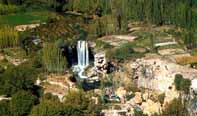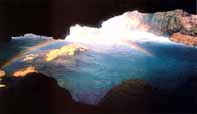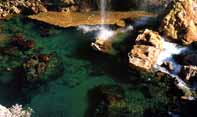|
With
a thundering sound rocks and boulders rolled down into the river
flowing along the valley floor. Plants, insects, branches, bushes
and trees were swept away down the steep slope. This landslide
carrying everything living with it made a dam across the Göksu, one
of the most secretive rivers on the Anatolian peninsula. Its course
blocked by earth and rubble, the river sought desperately to find a
way through. It had a single object, to reach the Mediterranean.
Finding some cracks beneath the mass of landslide debris, the water
bored into them, gradually creating a tunnel through which it could
continue on its way. Meanwhile the Karasu river, which prior to the
landslide had flowed into the Göksu here, was similarly endeavoring
to proceed on the upper side of the landslide fill, forcing its way
down through the loose earth between the great boulders, struggling
to reach the buried Göksu. Finally it achieved its aim, but then
hit another problem. Now the calcium deposited by the river waters
in the cracks as it flowed down them blocked this route, creating a
natural bridge over the Göksu made of debris cemented by lime. The
only way the Karasu could reach the Göksu now was to travel to the
end of the travertine bridge which it had made. At the end of the
bridge it spilled from a height of 15-20 m into the Göksu, again
precipitating lime along its new route.
|

|
The landslide had
caused a natural monument to come into being in the Toros mountain
range. Hadim Natural Bridge. That is the story of this remarkable
formation according to geologist Temuçin Aygen, who has spent years
studying many remarkable natural features in Turkey. The Toros
range, which is part of the great mountain system including the Alps
and the Himalayas, is one of the most rugged regions in Turkey. This
is due to a combination of the mountains structural
characteristics and climatic factors. The Toros are limestone
regions, in which streams and rivers carry away the calcium
carbonate in the limestone and so hollow out underground channels
for themselves, plunging into the ground to emerge several hundred
meters or even kilometers further on. The tunnels that they form,
and which occur in no other region of Turkey, are known locally as
yerköprü or ground bridges.
|

|
The Hadim Natural
Bridge is the most spectacular of the more than 20 which exist in
Turkey altogether. What distinguishes it from the others is the
Karasu river, which pours out of the base of a mountain near the
village of Çakallar 150 m north of the natural bridge. All along
its course the river unloads the calcium gathered on its passage
through the heart of the mountain, filling the cracks in the rocks
with lime mortar. This river is the architect-in-chief of the
astounding natural bridge. The Göksu makes an underground journey
of around 500 meters beneath the Hadim Natural Bridge, and over the
centuries the tunnel has been transformed into a cavern with two
gaping mouths. Unfortunately it is not possible for casual visitors
to pass right through the cave and out the other side, as in the
centre the way becomes so narrow that even the Göksu barely
wriggles through. Only cavers experienced in sump diving can make
the submerged crossing.
|

|
At both mouths of the
cavern the Karasu cascades down onto the Göksu. While the fall at
the upstream end is fairly unsubstantial, the downstream fall is
voluminous and spectacular.
The Hadim Natural
Bridge can be reached from several points, the easiest being the
main road leading south from Konya. But there are alternative routes
from both Ermenek and Karaman. From Konya take the Aladağ turning
to the left 10 km before the town of Hadim. The road soon begins the
descent into the Aladağ Valley. The first 20 km or so are
stabilised. Soon you will see the Göksu below, wreathed in green
vegetation. Further down the road passes through vineyards, and at
the turnoff to Bademli anyone will show you the narrow road to the
bridge.
The best way to make
the most of your visit is to take tents and camp by the river, or
leave early in the morning, as this is a sight worth setting aside
at least a day for. You must be prepared to get wet to enjoy Hadim
Natural Bridge to the full, so do not forget to take swimsuits,
towels, plastic bags and spare clothes with you.
When you get out of the
car follow the sound of the water and it will lead you to the
travertine platforms from which you can see the large waterfall on
the Karasu river. These platforms are a perfect place to set up
camp. To see this natural monument in all its beauty you must climb
down into the valley to the bottom of the waterfall. When you arrive
on the valley floor you will see the ongoing work of the Karasu all
around you -travertines in the process of formation, cascades of all
sizes, weed covered rocks with water trickling over them, and
limestone pools. You are in an open-air museum of cave formation.
If you want to proceed
further, then you must be prepared to climb rocks, pass right by the
cascading water, and get wet. The large waterfall pours into a small
lake which in places boils with currents and in others is calm and
blue. This is one of the best places to swim, although take care to
avoid the area of strong currents. The first time we went to Hadim
Natural Bridge, we
spent almost an entire
afternoon swimming in this pool and discovering natural diving
boards. In the intervals between swimming and diving we sunbathed on
the rocks. That weekend was like a trip to the seaside. On our next
visit we set out to explore the cave behind the waterfall. As we
approached the fall, rainbows of diverse sizes appeared in our path.
They moved with us at every step, always just a few meters ahead,
sometimes closer and sometimes further, just out of reach.
|

|
Everyone who comes here
should go behind the waterfall to see the extraordinary sight of a
great cavern and inside it the blue Göksu. The best way to get
behind the fall is to go down the left side of the valley, which
involves first being caught in a downpour, and then a swim of 8-10
meters through fast flowing water. An inflatable dinghy is
definitely an advantage here.
The interior of the
cave is as magical as the exterior. In the soft light filtering
through the net curtains of the fall, to the steady roar and
accompanying sound of dripping water from the ceiling, you can see
fronds of green weed hanging from the walls and travertine
formations of all kinds of shapes and sizes. Deeper into the cave it
becomes eerily darker.
Hadim Natural Bridge is
a place of rare beauty and fascination. However, it has its dangers,
and visitors should be warned to take care negotiating the slippery
rocks in places where the water has strong currents, to wear a
helmet into the cave, and choose their swimming spots carefully. In
short, do not get so carried away by the enchantment that you forget
to take sensible precautions.
If you are lucky enough
to come more than once, you will notice changes each time. The
formations grow and alter their shape, the water finds new courses
down which to flow, and new travertine are born. Anyway, having been
there once, the images imprinted on your memory will never leave you
in peace until they have dragged you back again.
|